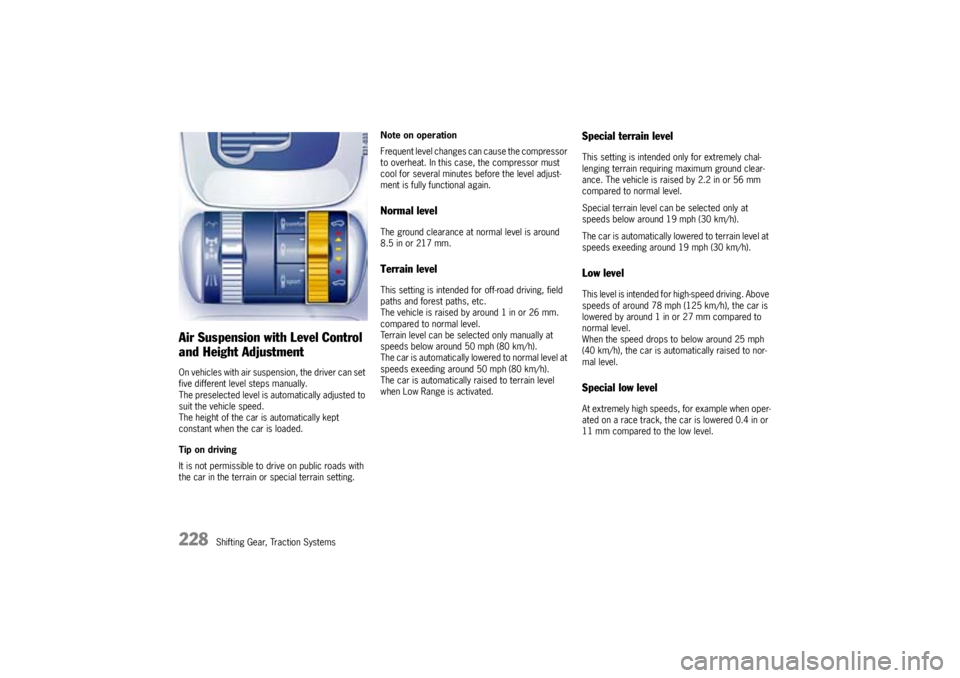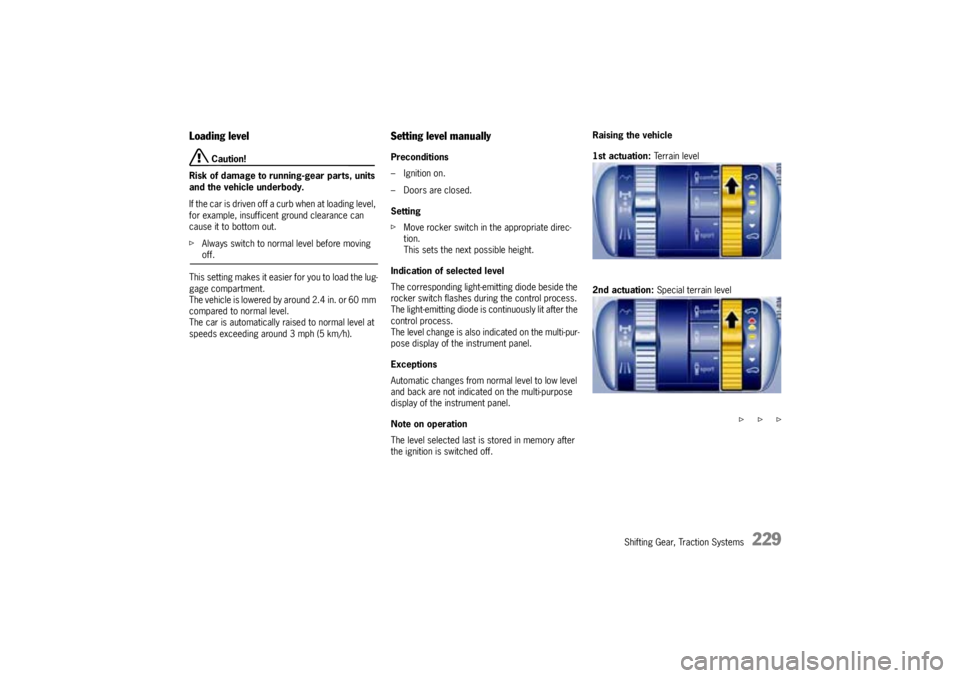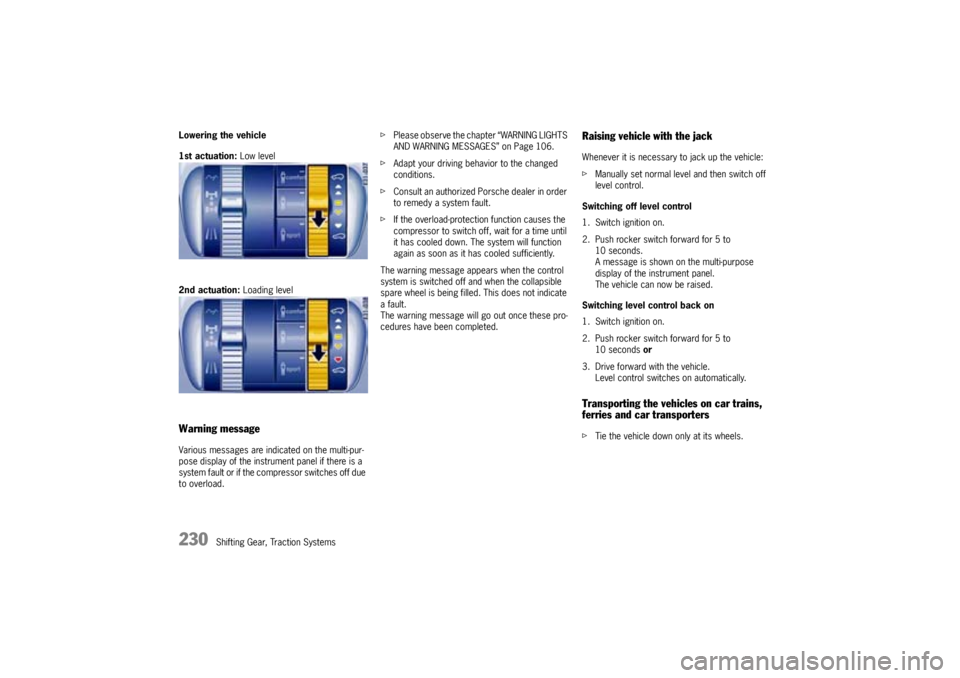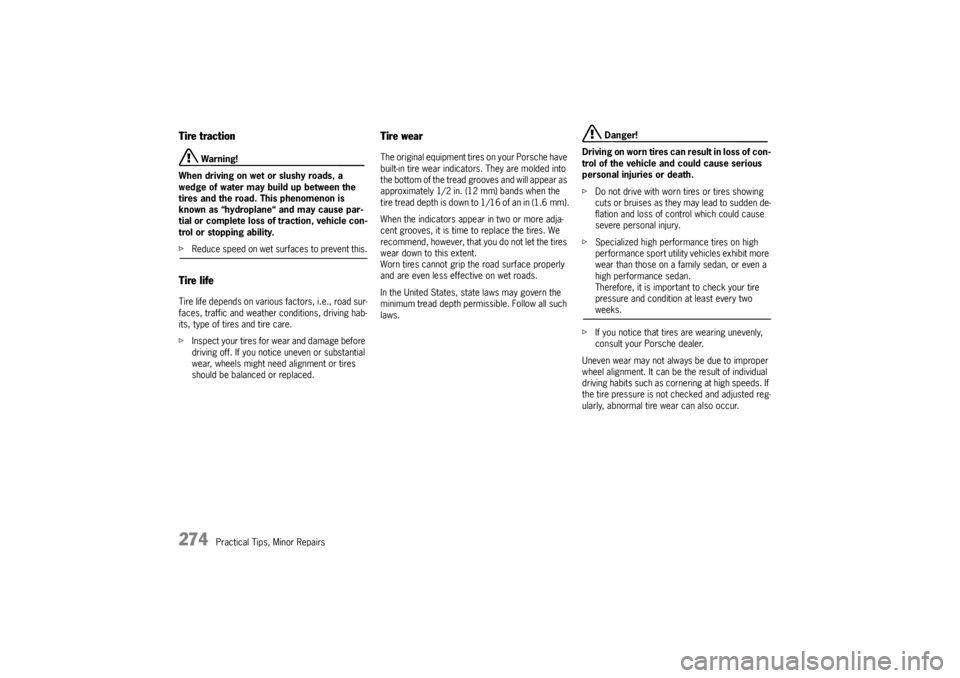traction control PORSCHE CAYNNE TURBO 2005 1.G Owner's Manual
[x] Cancel search | Manufacturer: PORSCHE, Model Year: 2005, Model line: CAYENNE TURBO, Model: PORSCHE CAYENNE TURBO 2005 1.GPages: 369, PDF Size: 3.17 MB
Page 221 of 369

Shifting Gear, Traction Systems
221
Driving systems for off-road drivingSpecially adapted driving programs or power-
transmission and running-gear control systems
are available for off-road driving:
– Off-road program Low Range
–Off-road PSM
–Off-road ABS
– Center differential lock
– Rear differential lock
fPlease observe the chapter “POWER-TRANS-
MISSION AND RUNNING-GEAR CONTROL SYS-
TEMS” on Page 211.Before driving offTires
fCheck tread depth and tire pressure.
fCheck for damage and remove any foreign ob-
jects (e.g. stones) from the tread.
fReplace missing valve caps.
Rims
fReplace dented or damaged rims before
driving off road.
After driving off roadOff-road driving places a greater burden on the ve-
hicle than does normal driving on roads.
We recommend inspecting the vehicle after off-
road driving. Potential damage poses an accident
risk and impairs driving comfort. Damage on the
car is recognised in good time if the car is
checked.
Warning!
Car damage poses an accident risk for the
vehicle occupants and other road users.
fIn cases of doubt, have your vehicle checked
by your authorized Porsche dealer.
fExamine tires for signs of damage such as
cuts, tears, bulges or foreign objects stuck in
the tread. Replace a damaged tire if necessa-
ry.
fHave any damage to your vehicle repaired by an authorized Porsche dealer without delay.
Recommended procedure
fDeactivate Low Range.
fClean headlights and tail lights and check them
for signs of damage.
fClean the front and rear licence plates.fClean the tire tread with a jet of water and re-
move any foreign objects.
fClean wheels, wheel housings and the under-
body with a jet of water.
fCheck whether the car has picked up plant
parts or branches.
These materials increase the risk of fire and
can damage fuel lines, brake hoses, boots of
the axle joints and drive shafts.
fAfter off-road driving, always check the entire
floor assembly, tires, body structure, steering
system, running gear and exhaust system for
signs of damage.
fAfter driving for an extended period through
mud, sand, water or substances with a similar
soiling effect, check the brake discs, brake
pads, wheels and axle joints and have them
cleaned.
fIf you experience severe vibrations after
driving off road, check the wheels for foreign
substances.
These substances can produce an imbalance
which might be responsible for the vibrations.
Removing these deposits may remedy the
problem.
Page 228 of 369

228
Shifting Gear, Traction Systems
Air Suspension with Level Control
and Height AdjustmentOn vehicles with air suspension, the driver can set
five different level steps manually.
The preselected level is automatically adjusted to
suit the vehicle speed.
The height of the car is automatically kept
constant when the car is loaded.
Tip on driving
It is not permissible to drive on public roads with
the car in the terrain or special terrain setting.Note on operation
Frequent level changes can cause the compressor
to overheat. In this case, the compressor must
cool for several minutes before the level adjust-
ment is fully functional again.
Normal levelThe ground clearance at normal level is around
8.5 in or 217 mm.Terrain levelThis setting is intended for off-road driving, field
paths and forest paths, etc.
The vehicle is raised by around 1 in or 26 mm.
compared to normal level.
Terrain level can be selected only manually at
speeds below around 50 mph (80 km/h).
The car is automatically lowered to normal level at
speeds exeeding around 50 mph (80 km/h).
The car is automatically raised to terrain level
when Low Range is activated.
Special terrain levelThis setting is intended only for extremely chal-
lenging terrain requiring maximum ground clear-
ance. The vehicle is raised by 2.2 in or 56 mm
compared to normal level.
Special terrain level can be selected only at
speeds below around 19 mph (30 km/h).
The car is automatically lowered to terrain level at
speeds exeeding around 19 mph (30 km/h).Low levelThis level is intended for high-speed driving. Above
speeds of around 78 mph (125 km/h), the car is
lowered by around 1 in or 27 mm compared to
normal level.
When the speed drops to below around 25 mph
(40 km/h), the car is automatically raised to nor-
mal level.Special low levelAt extremely high speeds, for example when oper-
ated on a race track, the car is lowered 0.4 in or
11 mm compared to the low level.
Page 229 of 369

Shifting Gear, Traction Systems
229
Loading level
Caution!
Risk of damage to running-gear parts, units
and the vehicle underbody.
If the car is driven off a curb when at loading level,
for example, insufficent ground clearance can
cause it to bottom out.
fAlways switch to normal level before moving off.
This setting makes it easier for you to load the lug-
gage compartment.
The vehicle is lowered by around 2.4 in. or 60 mm
compared to normal level.
The car is automatically raised to normal level at
speeds exceeding around 3 mph (5 km/h).
Setting level manuallyPreconditions
–Ignition on.
– Doors are closed.
Setting
fMove rocker switch in the appropriate direc-
tion.
This sets the next possible height.
Indication of selected level
The corresponding light-emitting diode beside the
rocker switch flashes during the control process.
The light-emitting diode is continuously lit after the
control process.
The level change is also indicated on the multi-pur-
pose display of the instrument panel.
Exceptions
Automatic changes from normal level to low level
and back are not indicated on the multi-purpose
display of the instrument panel.
Note on operation
The level selected last is stored in memory after
the ignition is switched off.Raising the vehicle
1st actuation: Terrain level
2nd actuation: Special terrain level
f f f
Page 230 of 369

230
Shifting Gear, Traction Systems Lowering the vehicle
1st actuation: Low level
2nd actuation: Loading level
Warning messageVarious messages are indicated on the multi-pur-
pose display of the instrument panel if there is a
system fault or if the compressor switches off due
to overload.fPlease observe the chapter “WARNING LIGHTS
AND WARNING MESSAGES” on Page 106.
fAdapt your driving behavior to the changed
conditions.
fConsult an authorized Porsche dealer in order
to remedy a system fault.
fIf the overload-protection function causes the
compressor to switch off, wait for a time until
it has cooled down. The system will function
again as soon as it has cooled sufficiently.
The warning message appears when the control
system is switched off and when the collapsible
spare wheel is being filled. This does not indicate
a fault.
The warning message will go out once these pro-
cedures have been completed.
Raising vehicle with the jackWhenever it is necessary to jack up the vehicle:
fManually set normal level and then switch off
level control.
Switching off level control
1. Switch ignition on.
2. Push rocker switch forward for 5 to
10 seconds.
A message is shown on the multi-purpose
display of the instrument panel.
The vehicle can now be raised.
Switching level control back on
1. Switch ignition on.
2. Push rocker switch forward for 5 to
10 seconds or
3. Drive forward with the vehicle.
Level control switches on automatically.Transporting the vehicles on car trains,
ferries and car transportersfTie the vehicle down only at its wheels.
Page 271 of 369

Practical Tips, Minor Repairs
271
Traction AA, A, B, C
The traction grades, from highest to lowest, are
AA, A, B, and C and they represent the tire's ability
to stop on wet pavement as measured under con-
trolled conditions on specified government test
surfaces of asphalt and concrete. A tire marked C
may have poor traction performance.
Warning!
The traction grade assigned to this is based on
braking (straight-ahead) traction tests and does
not include cornering (turned) traction, accelera-
tion, hydroplaning or peak traction characteris-
tics.Temperature A, B, C
The temperature grades are A (the highest), B and
C, representing the tire's resistance to the gener-
ation of heat and its ability to dissipate heat when
tested under controlled conditions on a specified
indoor laboratory test wheel.
Sustained high temperatures can cause the mate-
rial of the tire to degenerate and reduce tire life,
and excessive temperature can lead to sudden
tire failure.
The grade C corresponds to a level of perfor-
mance which all passenger car tires must meet
under the Federal Motor Vehicle Safety Standard
No. 109.
Grades B and A represent higher levels of perfor-
mance on the laboratory test wheel than the mini-
mum required by law.
Warning!
The temperature grade for this tire is estab-
lished for a tire that is properly inflated and
not overloaded.Excessive speed, underinfla-
tion, or excessive loading, either separately
or in combination, can cause heat buildup
and possible tire failure.
Page 274 of 369

274
Practical Tips, Minor Repairs
Tire traction
Warning!
When driving on wet or slushy roads, a
wedge of water may build up between the
tires and the road. This phenomenon is
known as “hydroplane“ and may cause par-
tial or complete loss of traction, vehicle con-
trol or stopping ability.
fReduce speed on wet surfaces to prevent this.Tire lifeTire life depends on various factors, i.e., road sur-
faces, traffic and weather conditions, driving hab-
its, type of tires and tire care.
fInspect your tires for wear and damage before
driving off. If you notice uneven or substantial
wear, wheels might need alignment or tires
should be balanced or replaced.
Tire wearThe original equipment tires on your Porsche have
built-in tire wear indicators. They are molded into
the bottom of the tread grooves and will appear as
approximately 1/2 in. (12 mm) bands when the
tire tread depth is down to 1/16 of an in (1.6 mm).
When the indicators appear in two or more adja-
cent grooves, it is time to replace the tires. We
recommend, however, that you do not let the tires
wear down to this extent.
Worn tires cannot grip the road surface properly
and are even less effective on wet roads.
In the United States, state laws may govern the
minimum tread depth permissible. Follow all such
laws.
Danger!
Driving on worn tires can result in loss of con-
trol of the vehicle and could cause serious
personal injuries or death.
fDo not drive with worn tires or tires showing
cuts or bruises as they may lead to sudden de-
flation and loss of control which could cause
severe personal injury.
fSpecialized high performance tires on high
performance sport utility vehicles exhibit more
wear than those on a family sedan, or even a
high performance sedan.
Therefore, it is important to check your tire
pressure and condition at least every two weeks.
fIf you notice that tires are wearing unevenly,
consult your Porsche dealer.
Uneven wear may not always be due to improper
wheel alignment. It can be the result of individual
driving habits such as cornering at high speeds. If
the tire pressure is not checked and adjusted reg-
ularly, abnormal tire wear can also occur.
Page 363 of 369

Index
363
NNavigation system ...................................... 170
Normal level ............................................... 228OOctane ratings ............................................ 252
Odometer .................................................... 75
Off delay ........................................... 104
,146
Off-road ABS ..................................... 218,223
Off-road driving ........................................... 220
Recommendation ................................ 221
Off-road shifting
Limit speed ............................... 207,210
Oil ............................................................. 235
Change .............................................. 239
Consumption ........................................ 14
Dipstick .............................................. 237
Filler opening ...................................... 237
Performance class .............................. 239
Temperature gauge .............................. 72
Topping up ......................................... 237
Viscosity ............................................ 239
Oil level
Checking ............................................ 236
On-board computer .............................. 78,181
Basic Screens ...................................... 79
Clock ................................................... 99
Collapsible spare wheel ......................... 90
Comfort ............................................. 101
Factory settings .................................. 105
Language ........................................... 105
Level.................................................... 83
Lighting .............................................. 104Load ....................................................91
Locks/reduction....................................84
Main menu ............................................80
Operation, controls ...............................78
Settings ...............................................99
Spare wheel..........................................90
System.................................................92
Tire pressure .................................85
,87
Tire sealant/sealing set .........................91
Tire type...............................................88
Tyre type ..............................................88
Units ..................................................104
Vehicle info ...........................................82
Warnings ..............................................83
Operating in other countries.........................249
Oxygen sensor ...........................................255
PPaint ..........................................................259
Panic button .................................................17
Panorama roof system ................................151
ParkAssist ................................157
,159
,195
Parking ......................................................204
Parking aid ..........................................34,157
Parking brake ...............................................62
Test stand ..........................................219
Warning light................................63,110
Parking heater ............................................137
Activating the memory .........................140
Faults .................................................141
Programming.............................138,139
Switching on and off ............................138
Parking light ...............................................117
Particle filter ...............................................245PASM ............................................... 211
,231
Display .............................................. 231
Indicator light ..................................... 110
Warning light ...................................... 231
Passenger compartment ............................ 193
Passenger compartment monitoring
system ............................ 21
,23,27,28,30
Passenger-seat drawer ...................... 172
,175
PCM .......................................................... 170
Person buttons ............................................ 33
Plastic parts .............................................. 262
Polishing.................................................... 259
Porsche Active Suspension
Management..................................... 211,231
Display .............................................. 231
Indicator light ..................................... 110
Warning light ...................................... 231
Porsche Communication Management ......... 170
Porsche Down-Hill Assistant ........................ 219
Porsche Entry & Drive .................. 24
,25,178
Immobilizer .......................................... 25
Opening/locking rear window ................ 24
Opening/locking spare wheel bracket .... 24
Porsche Stability
Management............................ 211
,214
,294
Deactivating ....................................... 216
Indicator light ..................................... 110
Information light ................................. 216
Off road ............................................. 215
Switching on ...................................... 216
Warning light ............... 68
,70,110
,216
Porsche Traction Management ........... 211,212
Power measurement .................................. 234
Power steering .......................................... 244